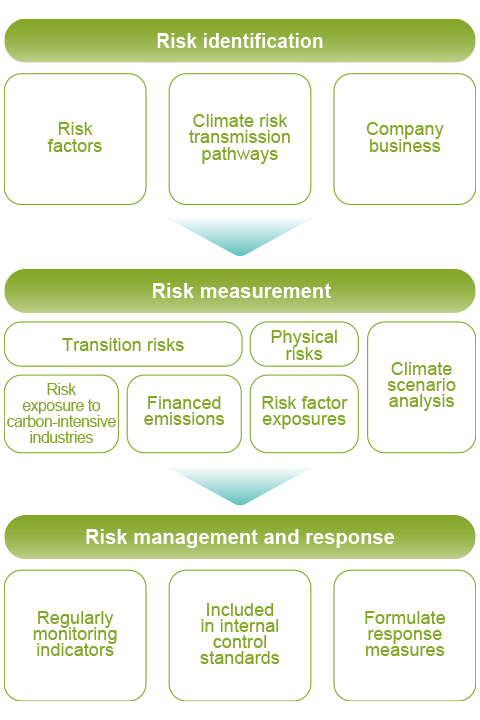Climate Governance
The Company has formulated a governance mechanism for risks and opportunities related to climate change in accordance with the Guidelines for Climate-related Financial Disclosures for the Insurance Industry promulgated by the competent authority. The Board of Directors bears the ultimate responsibility for managing climate-related risks.
The Company has included the management status of climate-related risks in its Risk Integration Report, which is submitted to the Board of Directors. Furthermore, the Company has established a Risk Management Committee under the Board of Directors. The committee is in charge of reviewing, establishing, and approving matters related to risk management. Matters related to the management framework and policy of climate-related risks and opportunities as well as climate-related risk appetite and other relevant matters all need to be submitted to the Risk Management Committee and then the Board of Directors for review. Moreover, in line with the aforementioned policy, the Company has established a Climate Change Risk Management Committee under the supervision of the President as well as formulated the committee’s charter. The committee convenes quarterly meetings. Its purpose is to compile and integrate the reports, suggestions, and decisions on issues related to climate risks from the Company and subsidiaries in order to assist management to fully realize its supervisory functions and ensure compliance. In addition, the risk management unit regularly reports climate risk-related issues to the Board of Directors. Issues are all reported in senior management meetings prior to being reported to the Board. The Company's climate governance is implemented through the three-tier management structure consisting of the Board of Directors, the Risk Management Committee, and the senior management meeting, as well as the three lines of defense of climate governance.
Climate Strategy
CTBC Holding’s Board of Directors has incorporated the goal of net-zero emissions by 2050 into the group’s long-term sustainable development roadmap. As one of its major subsidiaries, Taiwan Life supports this goal. We proactively identify and evaluate short-, medium-, and long-term climate risk factors and opportunities, integrating them into our relevant businesses, products, and investments. By conducting scenario analyses, we can seize strategic business development opportunities.
- According to Responsible Investment Regulations, the Company is required to take ESG risks into consideration when determining investment and financing asset allocations in order to reduce profit fluctuations in the overall investment/loan portfolio, in turn also reducing related risks. Therefore, prior to engaging in investment and financing activities, all units are required to assess whether a business or counterparty is associated with significant environmental issues (such as climate change and biodiversity), substantial social concerns, or major governance concerns that could significantly impact corporate value. This evaluation process specifically identifies oil sands and coal mining as carbon-intensive industries, as well as coal-fueled thermal power generation, which are regarded as industries with significant environmental concerns. Accordingly, the investment unit must review and limit our involvement in these industries in accordance with relevant regulations. Alternatively, any involvement in relevant businesses should only commence after a thorough evaluation has confirmed that the project aligns with sustainability criteria.
- The Company uses CTBC Holding’s list of carbon-intensive industries to determine whether an investment target operates in a carbon-intensive industry. In such cases, the Company will adjust the credit limit accordingly, utilizing the latest carbon footprint data (carbon emissions generated per unit of revenue) as announced by Reuters for reference. If an investment target demonstrates a consistent improvement in its carbon footprint over three consecutive years, the Company may consider increasing its credit limit. Conversely, if actual conditions warrant, the Company reserves the right to decrease the credit limit. Through these measures, we aim to ensure that our operations are aligned with our net-zero emissions goal while actively managing climate risks and seeking out sustainable growth opportunities.
Risk Management
In 2020, Taiwan Life’s Board of Directors approved the Sustainable Insurance Policy, which stipulates that insurance operations should take into account ESG-related issues, including climate risks and opportunities. In 2021, in accordance with Risk Management Best Practice Principles for the Insurance Industry and CTBC Holding' s Risk Governance Policy, we integrated climate change risk management principles into Taiwan Life’s Risk Management Core Strategy, Financial Transaction Credit Risk Management Policy, Operational Risk Management Policy, and Loan Credit Risk Management Policy as the framework for the overall business risk management of the Company and its subsidiaries, as well as amended the Responsible Investment Policy and Responsible Investment Regulations.
● Risk Management Procedures


Metrics and Targets
In compliance with CTBC Holding’s SBTi-based goals for Scope 1 and 2 greenhouse gas emissions, we have formulated an annual reduction target of 4.5% by 2035, with 2021 as the baseline year.
For the Scope 3 investments in listed companies, target management is conducted using the Temperature Rating method, and 2027 is set as the target year with a target temperature rise of 2.47°C. The Company's temperature performance in investments as of December 2023 was 2.22°C. This is in line with the carbon reduction pathway and we will continue to maintain this positive performance as well as to promote low-carbon business operations and the low-carbon transition through practical actions in order to achieve the 2050 net-zero goal.

